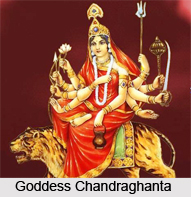 Goddess Chandraghanta is the third form of Goddess Durga among the Nava Durga. The goddess is worshipped on the third day of Navaratri. By worshipping the goddess devotees receive eternal strength.
Goddess Chandraghanta is the third form of Goddess Durga among the Nava Durga. The goddess is worshipped on the third day of Navaratri. By worshipping the goddess devotees receive eternal strength.
Attributes of Goddess Chandraghanta
Goddess Chandraghanta is golden in colour and has a bell shaped half moon on her forehead. It is for this reason that the goddess is known as Chandraghanta. The goddess rides a lion which is her vehicle. The goddess possesses ten hands. With five hands she holds weapons such as bow, arrow, trident, sword and a mace. With other three hands she holds rosary, lotus and a kamandala i.e. a pitcher. The last two hands depict the abhaya mudra and varada mudra. The goddess has three eyes. `Chandra Ghanta` means supreme bliss and knowledge. Her gesture portrays that she is always ready to proceed for the battlefield for a war. Thus, the goddess poses as an advocator of bravery and strength. The worshipper is also blessed with power and courage.
Worship of Goddess Chandraghanta
The worship of Goddess Chandraghanta as prescribed in the scriptures is performed on the third day of Navaratri. On this day the mind of the worshipper enters Manipura Chakra. While worshiping the goddess the devotee must worship all the gods, goddesses and planets in the kalash. Then all the other family members which includes Lord Ganesha, Lord Kartikeya, Goddess Saraswati, Goddess Lakshmi and Jaya-Vijaya are to be worshipped. Finally the goddess is to be worshipped. The following mantra is chanted while praying to the goddess.
Ya Devi Sarvabhuteshu Chandraghanta Rupen Sansthita |
Namastaseya Namastaseya Namastaseya Namo Namah ||
Pindah Pravarudha Chandkopastrakayurta |
Prasand Tnute Mahayam Chandraghanteti Vishruta ||
This article is a stub. You can enrich by adding more information to it. Send your Write Up to content@indianetzone.com









